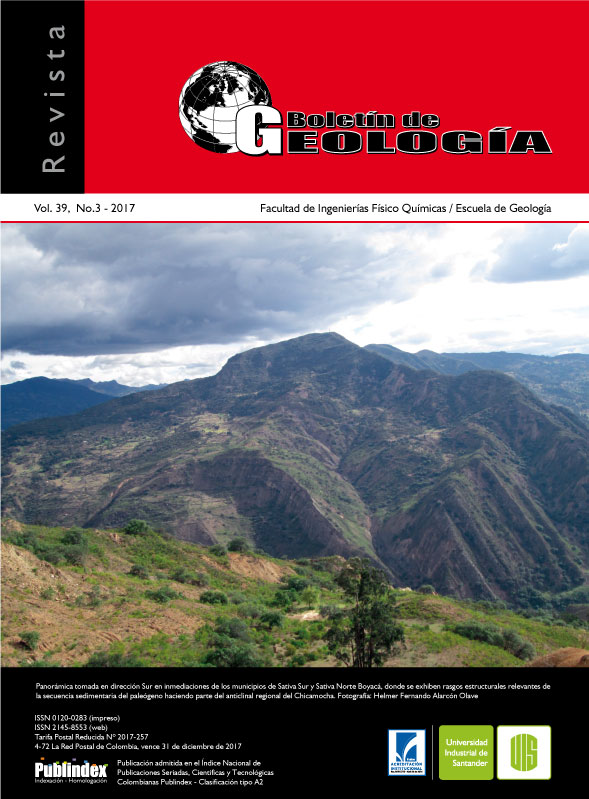ADVANCES OF FORENSIC GEOLOGY IN ARGENTINA: SEARCH WITH NON-INVASIVE METHODS FOR VICTIMS OF ENFORCED DISAPPEARANCE
Published 2017-10-06
Keywords
- Clandestine burial of persons,
- disappeared,
- geophysical methods
How to Cite
Altmetrics
Abstract
The forced disappearance of people has been a historical practice at world level specialized in the disposal and hiding of bodies using different methods and depths of burial. Latin America has not been the exception to this appalling practice, since victims of forced disappearance are recorded in several countries. About 21,000 people have been forcibly disappeared in Colombia at present and in the Argentine Republic it is estimated that between 9,000 and 30,000 people were also disappeared in the same way between 1976 and 1983 during a de facto government called “military dictatorship”. Since 1983, despite the period of successive democratic governments 210 involuntary disappeared people have been recorded until 2014. This situation in Argentina demands, in an imperative way, the training and specialization of forensic geologists, the improvement of techniques, and the development of new methodologies to be applied in the location of clandestine graves. The aim of this contribution is to present advances in prospection techniques for different types and forms of concealment of clandestine burials, with emphasis on the use of the ground penetrating radar. The use of GPR technology in the detection of anomalies corresponding to different forms of clandestine burials and mainly their concealment (buildings, concrete slabs, tanks, water pits and landfills, boulder deposits, limestone, vegetation, etc.) is recommended because it substantially increases the possibility of findings. The results obtained in the different cases of exploration with ground penetrating radar presented by the analogy or similarity that they have with real cases of different types of burial and hiding of clandestine graves are considered of interest.
Downloads
References
ATSS, 2016. Científicos Forenses: Cómo hacer que un desaparecido aparezca. Agencia TSS, Universidad Nacional de San Martín. Consultado el 11 de abril de 2016. http://www.unsam.edu.ar/tss/cientificos-forenses-como-hacer-que-un-desaparecido-aparezca/
CCI, 2010. Enciclopedia Criminalística, Criminología e Investigación. Sigma. Bogotá, pp. 1171-1181.
Davenport, G.C., France, D.L., Griffin, T.J., Swanburg, J.G., Lindemann, J.W., Trammell, V., Armbrust, C.T., Kondrateiff, B., Nelson, A., Castellano, K., and Hopkins, D. 1992. A multidisciplinary approach to the detection of clandestine graves. Journal of Forensic Sciences, 37(6): 1445-1458.
Gil-Pecharromán, J. 2016. Sangría en los Balcanes: 25 años del inicio de las guerras yugoslavas. El Mundo. España. Recuperado de: http://www.elmundo.es/la-aventura-de-la-historia/2016/03/31/56fa63e046163f57098b4575.html
González de Vallejo, L.I., Ferrer, M., Ortuño, L., y Oteo, C. 2002. Ingeniería Geológica. Prentice Hall. Madrid, 750p.
Hansen, J.D., Pringle, J.K., and Goodwin, J. 2014. GPR and bulk ground resistivity surveys in graveyards: Locating unmarked burials in contrasting soil types. Forensic Science International, 237: 14-29.
Irigaray, J.I. 2012. 197 desaparecidos y 3.500 asesinados en la democracia argentina. El Mundo. España. Recuperado de: http://www.elmundo.es/america/2012/12/10/argentina/1355163535.html
Molina, C.M., Saumett, M., and Romero, W. 2012. Using GPR to search mass graves. Applied and Environmental Geophysics, XIV Giambiagi Winter School. Buenos Aires, Argentina.
Molina, C.M., Pringle, J.K., Saumett, M., and Hernández, O. 2015. Preliminary results of sequential monitoring of simulated clandestine graves in Colombia, South America, using ground penetrating radar and botany. Forensic Science International, 248: 61-70.
Molina, C.M. 2016. Metodología para la búsqueda de fosas a partir de la interpretación de anomalías en los datos obtenidos mediante la aplicación de geofísica de alta resolución. Tesis Doctoral, Universidad Nacional de Colombia, Colombia. 129p.
Murray, R.C., and Tedrow, J.C.F. 1992. Forensic geology: Earth sciences and criminal investigation. Prentice Hall. New Jersey, 240p.
Pringle, J.K., Ruffell, A., Jervis, J.R., Donnelly, L., McKinley, J., Hansen, J., Morgan, R., Pirrie, D., and Harrison, M. 2012. The use of geoscience methods for terrestrial forensic searches. Earth-Science Reviews, 114(1-2): 108-123.
Pringle, J.K., Cassella, J.P., Jervis, J.R., Williams, A., Cross, P., and Cassidy, N.J. 2015. Soilwater conductivity analysis to date and locate clandestine graves of homicide victims. Journal of Forensic Sciences, 60(4): 1052-1060.
Puy Huarte, J. 1977. Procedimientos de sondeos: Teoría, práctica y aplicaciones. URPE. S.A. Madrid, 552p.
Pye, K., and Croft, D. 2004. Forensic geoscience: Principles, techniques and applications. Special Publication of the Geological Society of London. London, 232p.
Ruffell, A., and McKinley, J. 2008. Geoforensics. John Wiley and Sons. Belfast, 332p.
Ruffell, A., Pringle, J.K., and Forbes, S. 2014. Search protocols for hidden forensic objects beneath floors and within walls. Forensic Science International, 237: 137-145.
Sábato, E. 2006. Nunca Más. Informe de la Comisión Nacional sobre la Desaparición de Personas. Eudeba. Buenos Aires, 482p.
Sagripanti, G., Aguilera, D., Giaccardi, A., y Cornero, S. 2012. Exploraciones geofísicas en arqueología histórica: Iglesia San Francisco Xavier, siglo XIX, San Javier, Santa Fe. Revista del Centro de Estudios de Arqueología Histórica, 1(1): 179-188.
Sagripanti, G., Villalba, D., Aguilera, D., y Giaccardi, A. 2013. Geología forense: Métodos aplicados en la búsqueda de desaparecidos en la región central de Argentina. Revista de la Asociación Geológica Argentina, 70(1): 150-160.
Schultz, J.J. 2008. Sequential monitoring of burials containing small pig cadavers using ground-penetrating radar. Journal of Forensic Sciences, 53(2): 279-287.
Schultz, J.J., and Martin, M.M. 2011. Controlled GPR grave research: comparison of reflection profiles between 500 and 250 MHz antennae. Forensic Science International, 209(1-3): 64-69.
Schultz, J.J., and Martin, M.M. 2012. Monitoring controlled graves representing common burial scenarios with ground penetrating radar. Journal of Applied Geophysics, 83: 74-89.
Strongman, K.B. 1992. Forensic applications of ground penetrating radar; in Ground penetrating radar. Geological Survey of Canada, 90(4): 203-211.
